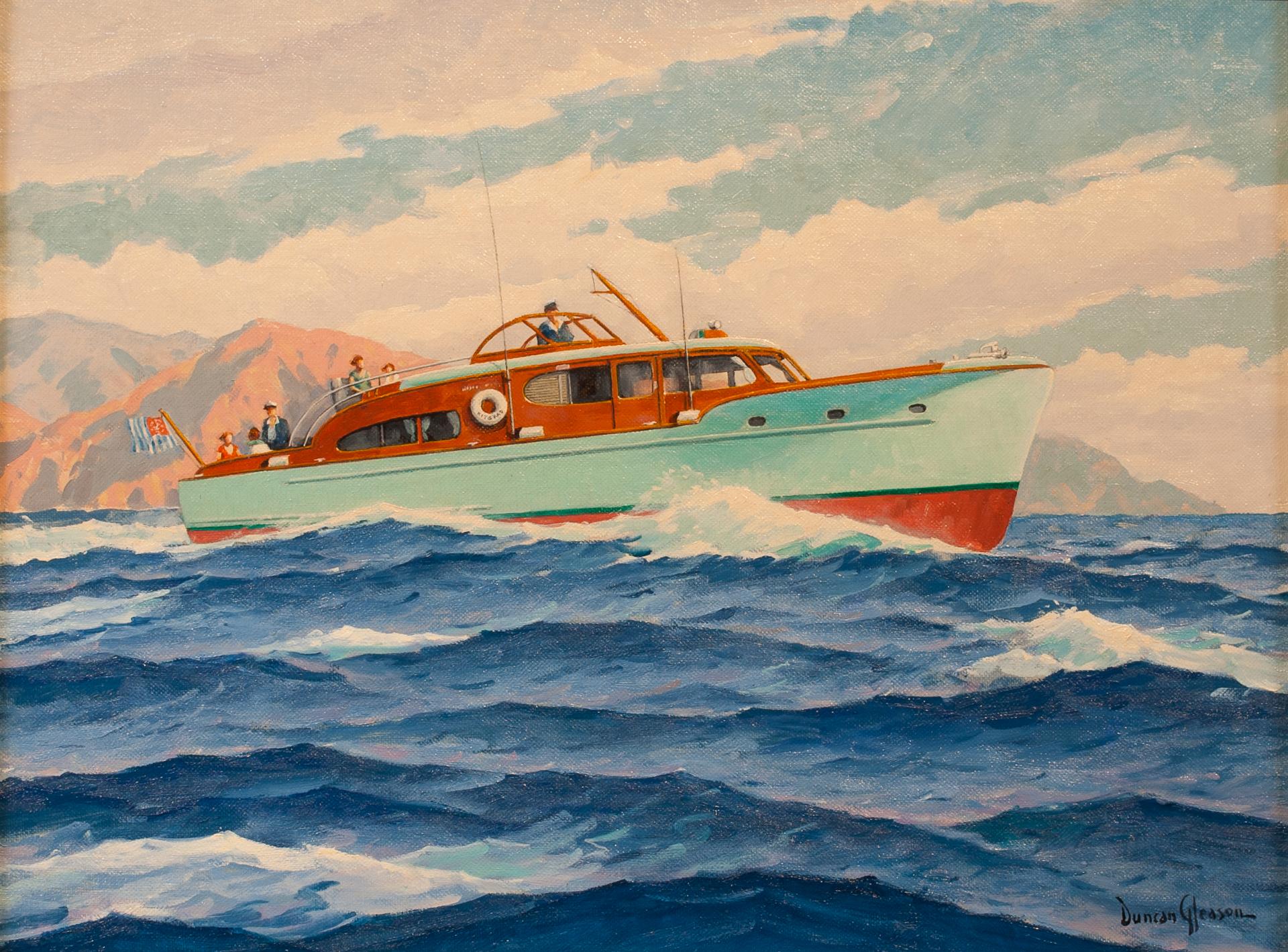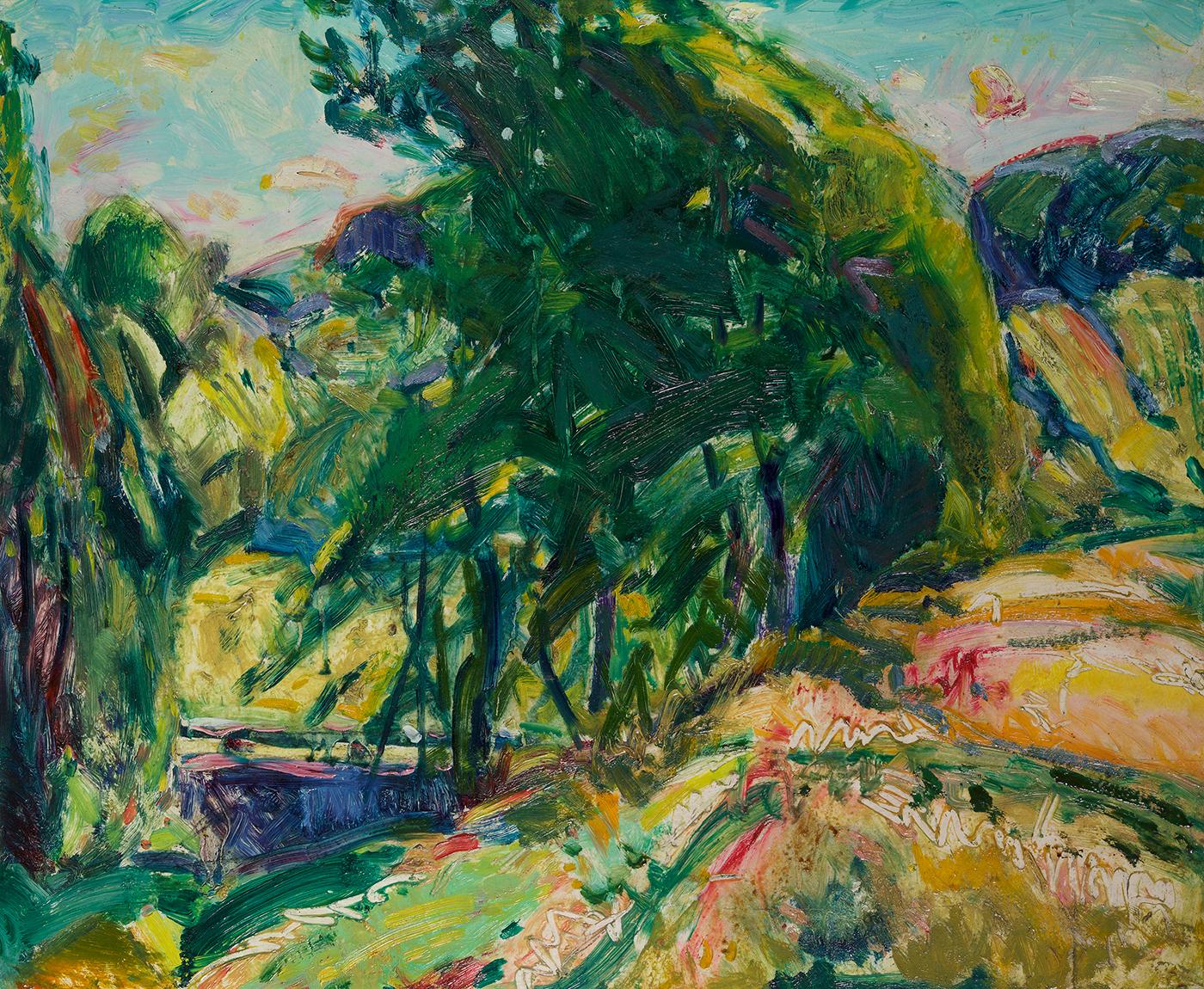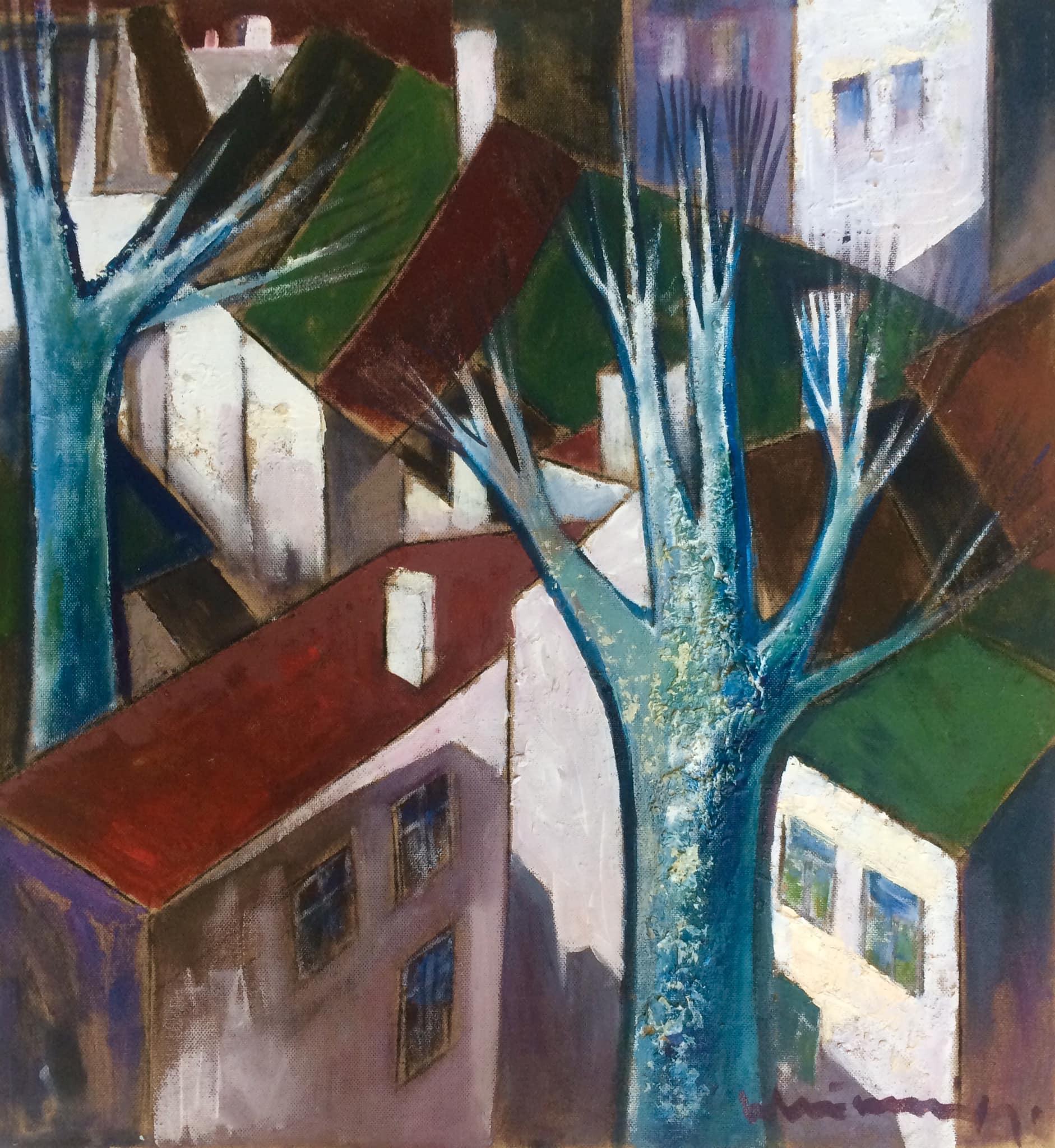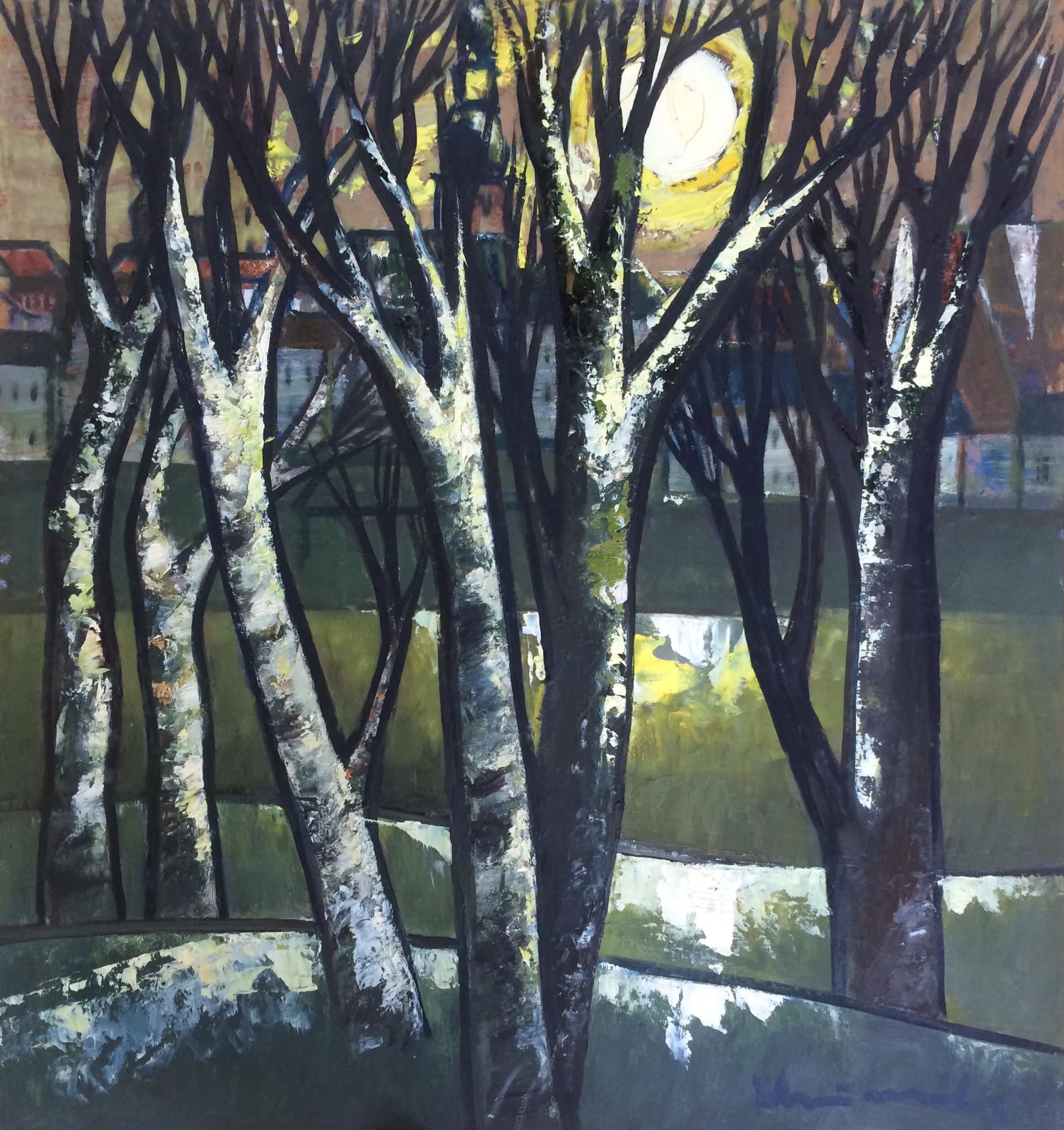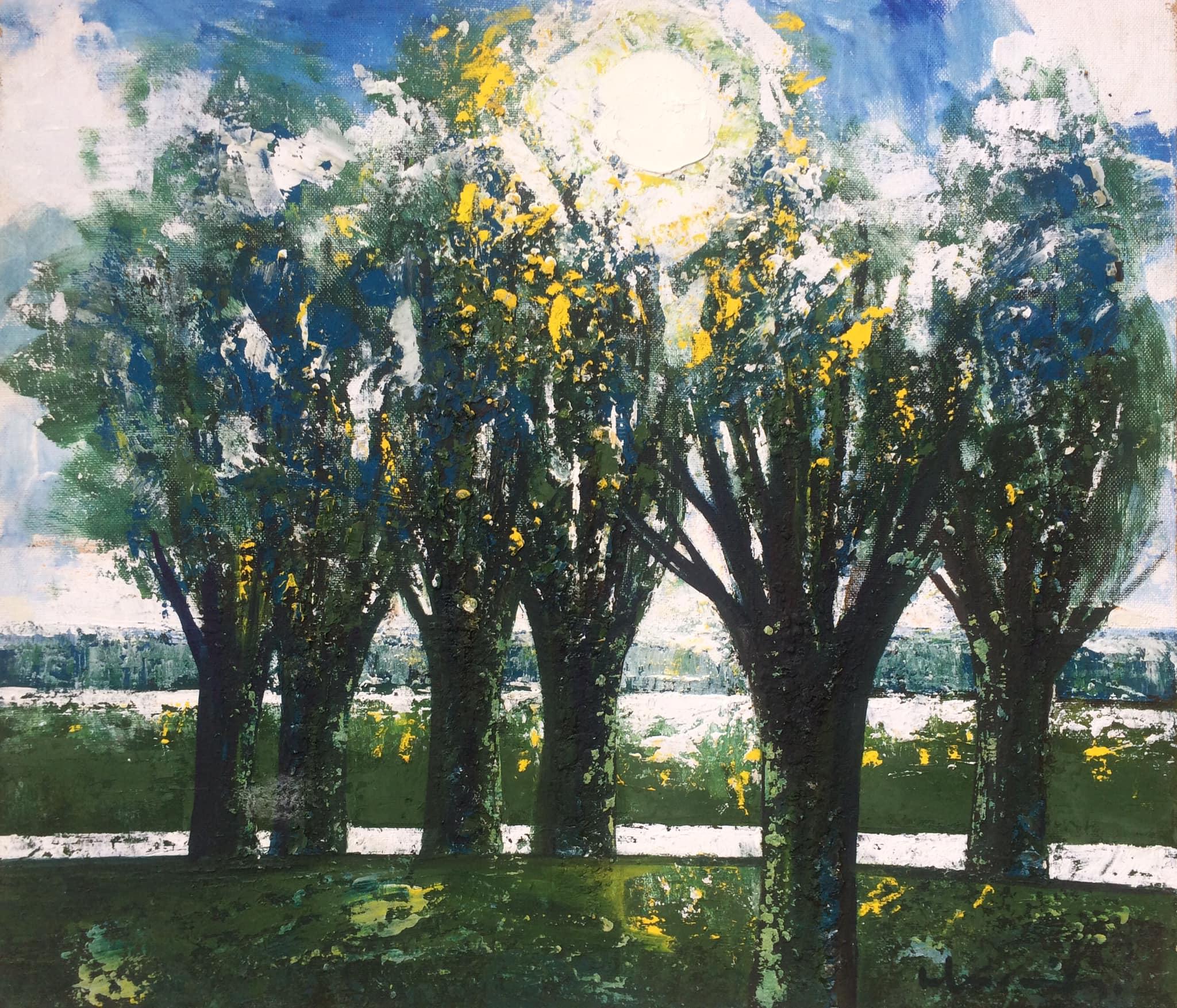Items Similar to Church and Churchyard - Landscape Painting, Mid-20th Century, Oil Paint, Modern
Want more images or videos?
Request additional images or videos from the seller
1 of 23
Joan GillchrestChurch and Churchyard - Landscape Painting, Mid-20th Century, Oil Paint, Modern
About the Item
Joan Gillchrest.
English ( b.1918 - d.2008 ).
Church and Churchyard.
Oil on Board. Signed.
Image size 33.9 inches x 21.8 inches ( 86cm x 55.5cm ).
Frame size 42.3 inches x 30.3 inches ( 107.5cm x 77cm ).
Available for sale; this original oil painting is by the Cornish artist Joan Gillchrest and dates from around the late 1960s.
The painting is presented and supplied undisturbed in its original hand painted frame (which is shown in these photographs) and mount. (The mount possibly hiding a date beneath the signature).
This vintage painting is in very good condition, commensurate with its age. It wants for nothing and is supplied ready to hang and display.
The painting is signed lower left.
Previously with the Tony Sanders Gallery, Penzance in May 1993.
Joan Gillchrest is one of Mousehole’s and Cornwall’s most recognised and celebrated artists. Her vibrant art sits firmly alongside other great artists of the St. Ives School from the 1960s.
She was born Joan Scott in London in 1918 into a wealthy and illustrious family. She was the third of four children. Her father was a pioneer of radiology – and a skilful caricaturist - and her Australian mother was an accomplished pianist. Sir George Gilbert Scott was her great grandfather, who designed the imposing Midland Grand Hotel at St. Pancras as well as countless parish churches. Grandfather, George Gilbert Scott Jnr, is remembered for three Cambridge colleges, Christ’s, Pembroke and Peterhouse. Her uncle Giles, (Giles Gilbert Scott) to whom Joan was close, is best known for his magnificent Anglican Liverpool Cathedral, Battersea Power Station and the iconic and ubiquitous red telephone box. Coming from such a long line of eminent architects it is not surprising that Joan always loved architecture and the churches and chapels of the Penwith peninsula feature prominently in her work. She said that buildings were “in her blood”.
Her early childhood was spent at the family home in Buckinghamshire, but she was a difficult child – the family hired one nanny for her and one for the other three children- and at one point she was sent to Upper Chine School in the Isle of Wright to give her family some peace! She was however the apple of her father’s eye and he encouraged her obvious artistic talent.
In 1934, aged only 15 but encouraged by her parents, she went to Paris to study art and learn the language. There she met Gwen John and studied in various studios, sometimes working as a model.
In 1936 she enrolled at the Grosvenor School of Art and subsequently studied there under Iain McNab, whom she described as a marvellous teacher. Her early artistic career was very promising; she first exhibited at the Royal Academy when she was just 18 and showed works at the New England Art Club in 1937 and the London Group in 1938.
When the Second World War broke out Joan was 21. She took a crash course in nursing and first aid and volunteered as an ambulance driver for Westminster Hospital. She later drove a mobile rescue unit. She was not able to paint much during the war but kept in touch with McNab; when the area around St Paul’s was blitzed, leaving the cathedral relatively unscathed, McNab got Joan and a few others to paint the scene. Her work, created with a thick paint and a palette knife, hung in the art school for many years.
Joan’s painting career stalled in the 1940s. In 1942 she married a barrister and Coldstream Guards officer Samuel Gillchrest, and they soon had a son, then a daughter. With a young family, she had little time to paint, and had to hide the work she did produce as her husband thought that work as an artist was beneath them. Sadly, the marriage broke down and in 1953 they divorced. In leaving a difficult marriage at this time, she forfeited money, security and her previous place in society.
Despite the huge changes in her life, her overwhelming desire to paint remained constant. She ignored the disapproval of her friends and family and started to explore new ways of expressing herself on canvas. She moved to a studio in Chelsea, an area much favoured by the artistic community. To support herself, her children and her painting she also found regular work as an artist’s model. She was tall, strikingly good looking and combined elegance with bohemianism. She also carried an air of mystery from her rich and privileged past, and so she became sought after as a fashion model.
In the flat below hers lived an artist who had enjoyed some professional acclaim, Adrian Ryan, and he and Joan soon struck up a relationship. Adrian Ryan was a friend of Augustus John’ son Edwin, who had been left his aunt Gwen’s Paris studio. Joan and Adrian thus began mixing in artistic circles, in both London and Paris. Betty John, Edwin’s wife, took herself off to Mousehole and in 1958 Joan and Adrian followed.
Joan immediately loved the Cornish coastal location and became part of the charmed circle of artists and itinerant creative people there. For a while Joan lived with Betty John, then sold a sapphire ring and a sable coat she had inherited and bought her own home, a cottage with the most spectacular views of Mousehole harbour and Mount’s Bay.
Adrian moved in with Joan, and for a while her cottage this became a family home for the couple and their respective children, when they were not at boarding school. However, Adrian Ryan was a man known more for his charm than his fidelity and their life together could be tempestuous. Moreover, he was not supportive of her artistic endeavours. Intent on consolidating his own status alongside St. Ives figures such as Peter Lanyon and Patrick Heron, Adrian dismissed her painting as ‘gimmicky’ and is reported to have turned her paintings to the wall if he expected important visitors. By 1965 Joan had had enough and she ended the relationship. Liberated from her partner’s disapproval she was at last able to express herself without constraint. Her own artistic style and confidence quickly flourished. She observed “It was only when I threw him out, I could do what I really wanted”. Her cartoonish humour, social narrative and deceptively simple, graphic wit came to the fore. It is said that she became a Cornish Beryl Cook, or Helen Bradley, fusing child-like innocence with highly sophisticated sensibility. Her work celebrates the joy of life, and records the everyday lives of those who holiday, live and work on the coastline with empathy and humour.
During this period Joan was encouraged by Jack Wood Palmer, and John Halkes, director of the Newlyn Orion Gallery, and began exhibiting again. Her first solo show in 1969 was at the Plymouth Art Gallery and for the next 20 years she exhibited at most of the Cornish galleries. From 1990 she also had an annual show with the Wren Gallery in Burford, Oxfordshire, and the London’s Design Centre. Since the 1980s Gillchrest’s work has sold from the Wren Gallery in Oxford and on the private market, with prices remaining very strong. A memorial exhibition was held at the Wren Gallery in 2008.
Joan Gillchrest was a very private person who never really understood the professional success she enjoyed and was bemused by the demand for her work. She said that she painted in order to give people enjoyment and rarely visited exhibitions, not wanting to be influenced by the work of others. She did not suffer fools gladly, but was warm, loving and generous to those who knew her. She built up a tremendous following and is recognised today as being one in a distinguished line of British naïve expressionists.
Joan Gillchrest died on 3rd January 2008, aged 89. One of her legacies to the community of Mousehole is the village Christmas lights. Joan put up the first string of lights outside her home in 1963 and now, every year, the village and its harbour are illuminated, and the event draws large crowds. Her work and her memory lives on.
© Big Sky Fine Art
- Creator:Joan Gillchrest (1918 - 2008)
- Dimensions:Height: 42.33 in (107.5 cm)Width: 30.32 in (77 cm)
- Medium:
- Movement & Style:
- Period:
- Condition:The painting is presented and supplied undisturbed in its original hand painted frame and mount. This vintage painting is in very good condition, commensurate with its age. It wants for nothing and is supplied ready to hang and display.
- Gallery Location:Sutton Poyntz, GB
- Reference Number:1stDibs: LU489314227412
About the Seller
5.0
Gold Seller
These expertly vetted sellers are highly rated and consistently exceed customer expectations.
Established in 2010
1stDibs seller since 2016
110 sales on 1stDibs
Typical response time: 1 hour
- ShippingRetrieving quote...Ships From: Sutton Poyntz, United Kingdom
- Return PolicyA return for this item may be initiated within 14 days of delivery.
More From This SellerView All
- The Harbor, St Michaels Mount, Cornwall. Exhibited 1982. Unique PerspectiveLocated in Sutton Poyntz, DorsetKen Symonds. English ( b.1927 - d.2010 ). The Harbor, St Michaels Mount, Cornwall, 1982. Oil on Artist’s Board. Signed. Image size 15.4 inches x 19.5 inches ( 39cm x 49.5cm ). Frame...Category
Late 20th Century Modern Landscape Paintings
MaterialsOil, Board
- Donald McIntyre. Girl and Chapel, North Wales. Modern British. Rural Welsh Life.By Donald McIntyreLocated in Sutton Poyntz, DorsetDonald McIntyre. English ( b.1923 - d.2009 ). Girl and Chapel, North Wales. Oil on card. Signed with monogram twice lower left. Image size 12 inches x 15.6 inches ( 30.5cm x 39.5cm ...Category
Late 20th Century Modern Landscape Paintings
MaterialsOil, Cardboard
- Llangynidr Bridge over the River Usk in Winter.Powys.Crickhowell.Wales.LandmarkLocated in Sutton Poyntz, DorsetAnthony Morris. English ( b.1938 ). Llangynidr Bridge over the River Usk in Winter. Oil on Board. Signed. Image size 6.7 inches x 8.7 inches ( 17cm x 22cm ). Frame size 10.4 inches ...Category
Late 20th Century Modern Landscape Paintings
MaterialsOil, Board
- Rural Derbyshire.A Palette of Blues, Greys & Greens.Impressionist.Nottingham ArtBy Arthur SpoonerLocated in Sutton Poyntz, DorsetArthur Spooner. English ( b.1873 - d.1962 ). Rural Derbyshire. Oil on Card. Signed. Image size 6.7 inches x 9.1 inches ( 17cm x 23cm ). Frame size 10.2 inches x 12.6 inches ( 26cm x...Category
Mid-20th Century Modern Landscape Paintings
MaterialsOil, Cardboard
- Cornish Fishing Boats at First Light. Mid-20th Century. Cornwall. Modern BritishBy Joan GillchrestLocated in Sutton Poyntz, DorsetJoan Gillchrest. English ( b.1918 - d.2008 ). Cornish Fishing Boats at First Light. Oil on Paper Mounted on Board. Signed with Monogram. Image size 26.2 inches x 22 inches ( 66.5cm x 56cm ). Frame size 35.8 inches x 31.3 inches ( 91cm x 79.5cm ). Available for sale; this original oil painting is by the Cornish artist Joan Gillchrest and dates from around the late 1980s. The oil painting is presented and supplied in a sympathetic new replacement frame (which is shown in these photographs) that suits the artwork’s color palette and behind non-reflective Tru Vue UltraVue® UV70 glass. This painting is in excellent condition and presents superbly. It wants for nothing and is ready to hang and display. The painting is signed with a monogram lower right. Joan Gillchrest is one of Mousehole’s and Cornwall’s most recognised and celebrated artists. Her vibrant art sits firmly alongside other great artists of the St. Ives School from the 1960s. She was born Joan Scott in London in 1918 into a wealthy and illustrious family. She was the third of four children. Her father was a pioneer of radiology – and a skilful caricaturist - and her Australian mother was an accomplished pianist. Sir George Gilbert Scott was her great grandfather, who designed the imposing Midland Grand Hotel at St. Pancras as well as countless parish churches. Grandfather, George Gilbert Scott Jnr, is remembered for three Cambridge colleges, Christ’s, Pembroke and Peterhouse. Her uncle Giles, (Giles Gilbert Scott) to whom Joan was close, is best known for his magnificent Anglican Liverpool Cathedral, Battersea Power Station and the iconic and ubiquitous red telephone box. Coming from such a long line of eminent architects it is not surprising that Joan always loved architecture and the churches and chapels of the Penwith peninsula feature prominently in her work. She said that buildings were “in her blood”. Her early childhood was spent at the family home in Buckinghamshire, but she was a difficult child – the family hired one nanny for her and one for the other three children- and at one point she was sent to Upper Chine School in the Isle of Wright to give her family some peace! She was however the apple of her father’s eye and he encouraged her obvious artistic talent. In 1934, aged only 15 but encouraged by her parents, she went to Paris to study art and learn the language. There she met Gwen John and studied in various studios, sometimes working as a model. In 1936 she enrolled at the Grosvenor School of Art and subsequently studied there under Iain McNab, whom she described as a marvelous teacher. Her early artistic career was very promising; she first exhibited at the Royal Academy when she was just 18 and showed works at the New England Art Club in 1937 and the London Group in 1938. When the Second World War broke out Joan was 21. She took a crash course in nursing and first aid and volunteered as an ambulance driver for Westminster Hospital. She later drove a mobile rescue unit. She was not able to paint much during the war but kept in touch with McNab; when the area around St Paul’s was blitzed, leaving the cathedral relatively unscathed, McNab got Joan and a few others to paint the scene. Her work, created with a thick paint and a palette knife, hung in the art school for many years. Joan’s painting career stalled in the 1940s. In 1942 she married a barrister and Coldstream Guards officer Samuel Gillchrest, and they soon had a son, then a daughter. With a young family, she had little time to paint, and had to hide the work she did produce as her husband thought that work as an artist was beneath them. Sadly, the marriage broke down and in 1953 they divorced. In leaving a difficult marriage at this time, she forfeited money, security and her previous place in society. Despite the huge changes in her life, her overwhelming desire to paint remained constant. She ignored the disapproval of her friends and family and started to explore new ways of expressing herself on canvas. She moved to a studio in Chelsea, an area much favored by the artistic community. To support herself, her children and her painting she also found regular work as an artist’s model. She was tall, strikingly good looking and combined elegance with bohemianism. She also carried an air of mystery from her rich and privileged past, and so she became sought after as a fashion model. In the flat below hers lived an artist who had enjoyed some professional acclaim, Adrian Ryan...Category
Mid-20th Century Modern Landscape Paintings
MaterialsPaper, Oil, Board
- A Young Richard Burton and His Father. Pontrhydyfen. Neath Port Talbot. Wales.Located in Sutton Poyntz, DorsetPeter Ross. English (b.1941) The Young Richard Burton and his father. Welsh Coal Mining Community. Oil on Board. Signed. Image size 24 inches x 24 inches ( 61cm x 61cm ). Frame size 25.2inches x 25.2inches (64cm x 64cm ). Available for sale; this original painting is by Peter Ross and dates from 2013. The painting is presented and supplied in a contrasting contemporary floating frame (which is shown in these photographs). This painting is in superb condition. It wants for nothing and is supplied ready to hang and display. The painting is signed lower left. Peter Ross is a Welsh artist living in England and currently producing paintings about his childhood in South Wales in the 1950’s and 60’s. Peter was born in Llanfrechfa, South Wales in 1941. He grew up in Newport and studied at Newport Art College from 1958-62 and then at Bristol Art College from 1962-63. For most of his working life he worked as an art teacher in secondary schools and before retiring in 2007, as an art technician. He now teaches life drawing to adults and exhibits his work in galleries in England and Wales. Since his time as an art student Peter has continued to paint for himself. He has always chosen themes which appealed to him at specific times such as conflict, journeys, faces and cultural/literary figures. Each phase of interest and painting usually lasting one to two years and resulting in an exhibition before starting on the next subject of interest. Peter’s work has been mostly narrative-based or representational, with one abstract phase immediately after leaving art college. In recent years his interest has returned to his childhood and his memories of Newport, South Wales. These paintings are based on family and archive photographs, memories, research and other influences like Dylan Thomas. Peter has had numerous one person and joint shows. His has also taken part in the Royal Academy Summer Show, The Arts Council of Wales, South Wales Group and Welsh Artist of the Year Show 2008. He has recently exhibited at the Riverfront Gallery in Newport, the Ardent Gallery, Brecon and the Nick Holly...Category
21st Century and Contemporary Contemporary Portrait Paintings
MaterialsOil, Board
You May Also Like
- The Yacht KITSKAD Off Catalina IslandBy J. Duncan GleasonLocated in Costa Mesa, CADuncan Gleason lived in New York and other places for work or studies but it was really Southern California where he felt most at home, and looking at his body of work, that love of ...Category
1950s Modern Paintings
MaterialsCanvas, Oil, Board
- Sunlit BayBy Henry Martin GasserLocated in New York, NYOn verso: H GASSERCategory
Mid-20th Century Modern Landscape Paintings
MaterialsBoard, Oil
- Landscape with Green TreeBy Alfred Henry MaurerLocated in New York, NYAlfred Henry Maurer has been called the First American Modern because of his role in bringing modern methods of working to the United StatesCategory
Early 20th Century American Modern Landscape Paintings
MaterialsOil, Board
- Roofs. 1991, oil on cardboard 91x85 cmLocated in Riga, LVLaimdots Murnieks had a significant influence on the development of Latvian painting at the end of the 20th century. His work 'Holiday' conveys the feeling lightness and joy, which i...Category
1990s Modern Landscape Paintings
MaterialsOil, Cardboard
- Wind gestures. 1991. Oil on cardboard. 91, 5x85 cmLocated in Riga, LVWind gestures. 1991. Oil on cardboard. 91,5x85 cm This depiction of trees shows artist Laimdots Murnieks as a master of nature representation. Ev...Category
Late 20th Century Modern Landscape Paintings
MaterialsOil, Cardboard
- Spring. 1997, oil on cardboard, 74x85 cmLocated in Riga, LVLaimdots Murnieks had a significant influence on the development of Latvian painting at the end of the 20th century. His work 'Holiday' conveys the fee...Category
1990s Modern Landscape Paintings
MaterialsOil, Cardboard
